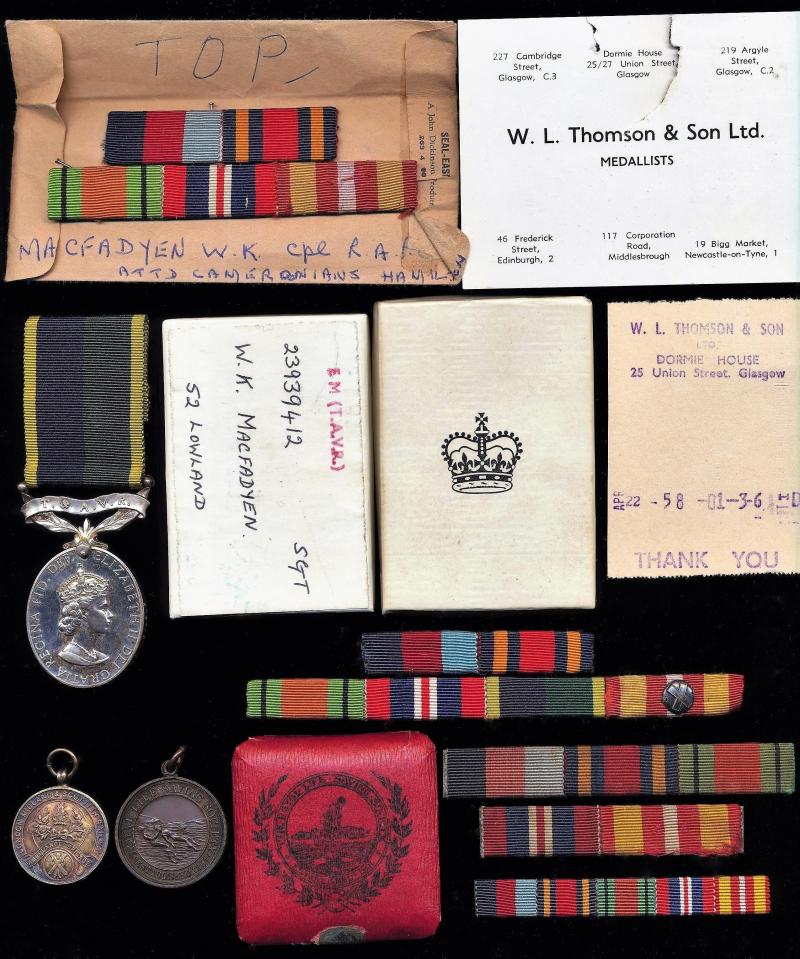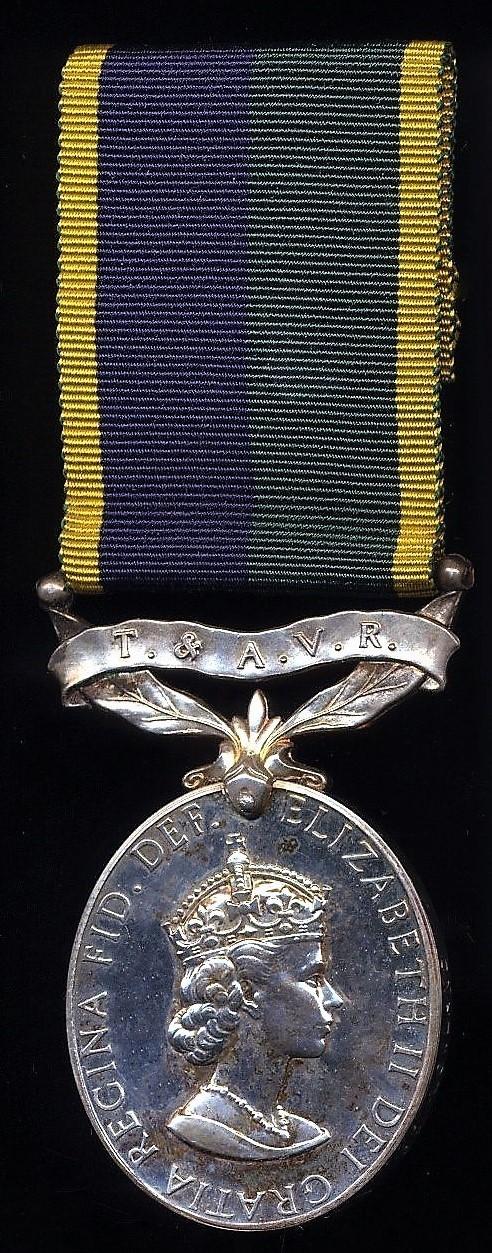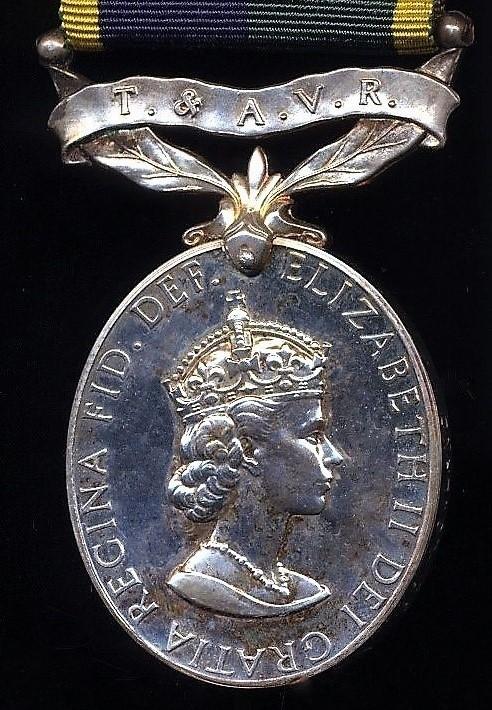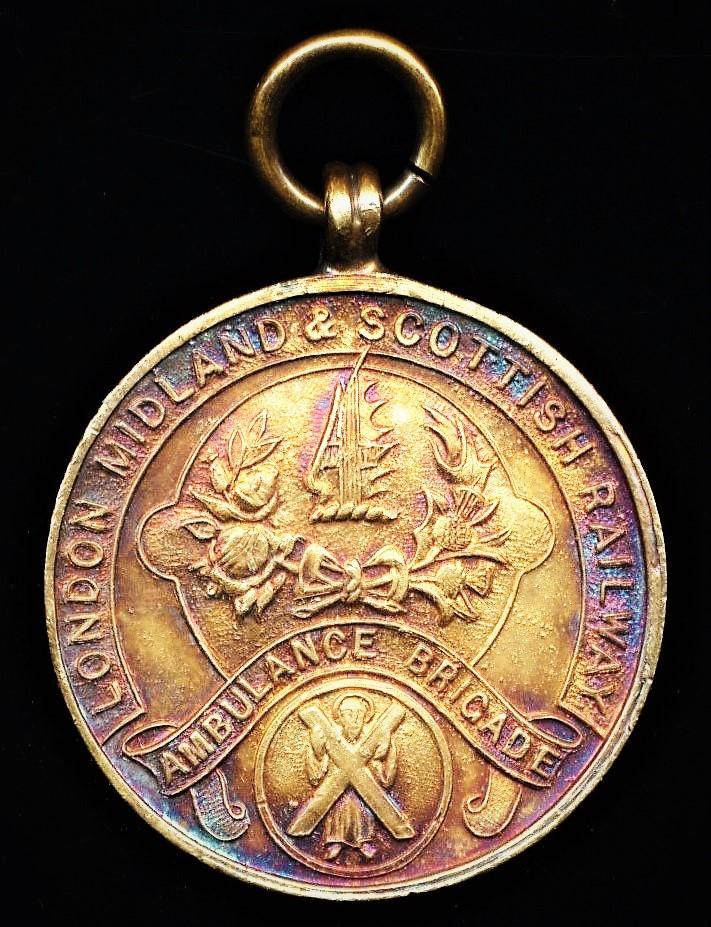A Scottish 'Chindit' lot including Efficiency Medal. EIIR issue with 'T & A V R' bar: Sergeant William Kennedy McFadyen, 52nd Lowland Volunteers, late Royal Artillery
Efficiency Medal EIIR issue with 'T & A V R' bar (23939412 Sgt. W. K. McFadyen 52 Lowland)
Note: The Efficiency Medal with clasp 'T & A V R' bar was only issued between 1967-1982
Medal sold together with the original named white card box of issue, and silk ribbon bars as-worn by the recipient with ribands of:
- The 1939-1945 Star
- The Burma Star
- Defence Medal
- War Medal
- Efficiency Medal (T & A V R riband)
- Voluntary Service Medal
Also sold together with:
- London Midland & Scottish Railway Ambulance Brigade (Scotland Division): Long Service Medal (W. McFadyen 5919 1946)
- Royal Life Saving Medal. Bronze. Cased in leatherette case of issue the medal named & dated to W. K. McFadyen Nov 1928)
- Receipt for medal and ribbons mounting dated April 1958
- Medal mounters business card
- Brown manila envelope with recipients service / unit details from circa 1958
London Midland & Scottish Railway Ambulance Brigade (Scotland Division): Silver-gilt medal (W. McFadyen 5919 1946)
Maker: With makers marks for 'Alexander Clark & Company' on reverse
Metal: Silver gilt (silver hallmarks for Birmingham, 1948)
Dimension: 26mm
Important: The medal was awarded with different obverse designs for 'England' & 'Scotland'. This medal being the scarcer 'Scotland Division'
William Kennedy McFadyen, was the third and youngest son of Colour Sergeant Andrew Kennedy McFadyen (a 'Professional Soldier' with Highland Light Infantry) and Amelia Sarah Jane McFadyen (nee Titcombe). Of paternal Scottish heritage, William was born in Reading, Berkshire, on, 14 August 1914. After leaving school, William pursued a career as a Merchant Seaman, being employed and serving variously with: Williamson-Buchanan Turbine Steamers Ltd; Clan Line Steamers Ltd & London Midland & Scottish Steamship Services. During the Second World War, circa 1940, William enlisted in the British Army, and was allocated the unique British Army number 991690 - from the block allocated to the Royal Artillery in 1920 - on being posted to the Royal Regiment of Artillery (he joined 6th Field Training Regiment on, 15 December 1940), and from there was posted to the 155th (Lanarkshire Yeomanry) Field Regiment, Royal Artillery, and deployed to India. Most of 155th (Lanarkshire Yeomanry) Field Regiment, Royal Artillery, shipped to Malaya, where the remnants of the unit were captured, at the fall of Singapore Colony, on,15 February 1942. However, 1 x battery, including William McFadyen remained behind in India, where the unit formed the nucleus of the newly raised, 160th Field Regiment Royal Artillery, and subsequently served in Burma under higher formation 14th Army, during which time he served as a 'Chindit' (the medals were sourced with a wide ensemble of insignia worn by William Kennedy McFadyen, including, Chindits - Special Force - cloth sleeve insignia, Lanarkshire Yeomanry insignia, & Royal Artillery badges, all of which are being listed and sold separately form the medals. William's extant Royal Artillery Attestation record, held and accessible at The National Archives, shows that he was transferred to the Essex Regiment on, 14 October 1944 - which date and posting is significant
Chindit Service 51st/69th Regiment Royal Artillery: From February to April 1943 Major-General Orde Wingate's Long Range Penetration (LRP) Groups, the 'Chindits', had carried out their first operation into Japanese-held Burma (Operation Longcloth). After the lessons learned it was decided to increase 'Special Force' to six brigades for future operations, and 70th Division was selected to be broken up to provide three of these. 16th Brigade and 51st (W&C) Field Rgt left the division on 29 September 1943. In September the regiment was joined by 587 (Independent) Field Bty, which had been formed in India in 1942 from a troop of A Bty, 160th Field Rgt. The augmented regiment then handed in its guns and began converting to an infantry role. On 18 October 51st (W&C) Field Rgt was amalgamated with 69th (Duke of Connaught's Hampshire) Light Anti-Aircraft/Anti-Tank Rgt to form an infantry battalion designated 51st/69th Regiment, RA, which trained in the LRP role
The combined regiment formed 51 and 69 Columns of 16th Bde for the Second Chindit Expedition (Operation Thursday). After several changes of plan, 16th Bde under Brig Bernard Fergusson began its long march from Ledo in Assam into Burma on 5 February, proceeding down a single-file track towards Hkalak Ga. The going was extremely difficult, and the head of the brigade took until 16 February to cover the 35 miles (56 km) to Hkalak Ga. Progress was then quicker, and the brigade reached the Chindwin River on 28 February, 10 days behind schedule. It turned a sandbank into an airstrip and then began crossing the river on 1 March aboard assault boats brought in by gliders. The head of the column moved off that night towards its objective of Indaw, detaching two columns (possibly 51 and 69) to attack Lonkin. The rest of 16th Bde established a stronghold codenamed 'Aberdeen' near Manhton and on 22 March gliders flew in material to construct an airstrip. The fresh 14th Bde then began to be flown in on 23 March, but 16th Bde was ordered to attack Indaw without time for concentrate or for rest after its long march. The other six columns of the brigade made the attack, but it failed with heavy casualties. Fergusson then concentrated his brigade in the hills to reorganise and await support
By the beginning of April 16 Bde was back at 'Aberdeen', while the fresh Chindit formations were being flown in to continue the operation. It was then decided to fly out the exhausted units of 16th Bde. The brigade was moved to Comilla in East Bengal and by 17 May was at Bangalore in India. About a quarter of the personnel of 51st/69th Rgt were sent to the UK, either because they were unfit for further service after their exertions and sickness or were eligible for repatriation under the 'Python' scheme after three years and eight months' overseas service. The remainder of the regiment were drafted to 1st Battalion Essex Regiment, which had also returned from the Chindit expedition, and continued as infantry until the end of the war. However, the Chindits did not see action again and 'Special Force' was disbanded in February 1945
Post War: In the late 1950's William enlisted in the Territorial Army, being allocated the unique army number 23939412, and in 1958, was holding the rank of Corporal while serving with the Royal Army Pay Corps attached to the Cameronians, where he was based at Hamilton, Lanarkshire, Scotland. By the time he was awarded the EM TAVR, he held the rank of Sergeant, and although in his 50's (he was born in 1914) would have been retained in the TAVR under special conditions due to his specialist services / qualifications
A fine assemblage of awards and insignia to a former 'Chindit Soldier'
See other separate listings for 'McFadyen' including badges and his father's medal & regimental insignia
Condition:The EM is EF
Code: 22501







